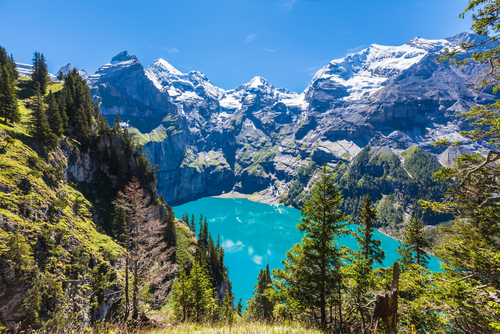The culture and history of glaciers in the Alps
As striking features of the natural environment, glaciers often play a role in the history and culture of the regions where they are found. In some places glaciers are revered: Quechua pilgrims travel into Peru’s high Andes to visit sacred glaciers during the religious Quyllurit’i festival. But in pre-enlightenment Europe, glaciers were more often viewed with fear due to the destructive forces they could unleash on local communities. The myth of the cursed glacier found in the European Alps is a good example of this sentiment.
In the myth, the residents of a prosperous town become so corrupted by their good fortune that they begin to clean the streets with bread and milk. But when a beggar asks the townspeople for some bread to eat his humble request is denied. The beggar curses the town, and dark clouds soon begin to fill the skies. A relentless snow storm then batters the area for many days. When the clouds finally break both the town and its fertile surroundings are forever buried beneath the thick ice of a glacier.
Some historians have suggested that the myth of the cursed glacier may have some basis in fact. From the 16th to the 19th century, Europe experienced a period of cooling temperatures called the “Little Ice Age.” Alpine glaciers regularly advanced during this period, causing difficulties for highland farms and villages. Some historians even go so far as to link cool temperatures with famines that helped spark the French Revolution.
But Europe’s Little Ice Age also posed something of a scientific mystery: why did glaciers in the Alps begin retreating around 1850 even though temperatures didn’t warm significantly until the end of the century? Scientists now believe the culprit was the Industrial Revolution.
Black carbon, or soot, from industry, steam locomotives, domestic fires and other sources blanketed parts of Europe during the Industrial Revolution, which took place from approximately 1760 to 1840. Airborne black carbon is second only to CO2 in the amount of heat it traps in the atmosphere, and as it is a particle it eventually falls back to earth with rain or snow. Black carbon can darken the surface of a glacier and lower its albedo, or ability to reflect solar energy, thus causing it to absorb more heat and melt more quickly. This effect may explain why glaciers in the Alps began to retreat in the 1850s even though climate and precipitation records indicate they should have continued advancing for another 50 years.
As glaciers have continued to recede across Europe, some Alpine communities have taken unusual steps to protect them. During the summer months, the tongue of Switzerland’s Rhone glacier has been covered with blankets to help insulate it, and researchers have proposed spraying artificial snow on the popular Morteratsch glacier to help slow its retreat. But such measures may only delay the inevitable: scientists have suggested that the Alps’ glaciers may be gone by the turn of the next century.

